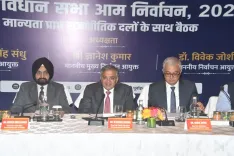Why Did Ashok Leyland's Q1 Profit Plunge by 47%?

Synopsis
Key Takeaways
- Net profit decreased by 47.21% in Q1 FY26.
- Revenue fell by 20.32% compared to Q4 FY25.
- YoY net profit increased by 20% from the previous fiscal year.
- Record Q1 sales with 44,238 units sold.
- Cash surplus of Rs 821 crore at the end of the quarter.
Mumbai, Aug 14 (NationPress) Ashok Leyland announced a significant sequential decline in its consolidated net profit for the April–June quarter (Q1 FY26), with earnings decreasing by 47.21 percent to Rs 657.72 crore from Rs 1,245.92 crore in the previous quarter (Q4 FY25).
Revenue from operations also fell by 20.32 percent to Rs 11,708.54 crore, compared to Rs 14,695.55 crore in Q4 FY25, as disclosed in its stock exchange filing.
The company’s total income mirrored the revenue decline, dropping to Rs 11,807.2 crore from Rs 14,817.18 crore in the preceding quarter.
Nevertheless, total expenses also saw a reduction of 16.62 percent, amounting to Rs 10,920.53 crore, down from Rs 13,097.25 crore sequentially.
On a year-on-year (YoY) basis, however, Ashok Leyland experienced robust growth. Net profit increased by 20 percent from Rs 550.65 crore in the same quarter of the previous fiscal year, while revenue rose by 9.4 percent from Rs 10,697 crore.
Operating profit (EBITDA) surged by 18 percent YoY to Rs 2,173 crore, with margins improving to 18.5 percent from 17.2 percent.
The Hinduja Group’s commercial vehicle division also marked record Q1 sales, achieving its highest-ever CV volumes of 44,238 units.
Medium and heavy commercial vehicle (MHCV) truck volumes (excluding Defence) increased by 2 percent YoY, enhancing market share from 28.9 percent to 30.7 percent.
MHCV bus volumes grew by 5 percent, enabling the company to retain its domestic market leadership in this segment.
Exports surged by 29 percent YoY to 3,011 units, while the light commercial vehicle (LCV) segment recorded domestic sales of 15,566 units.
Power solutions, aftermarket, and defense sectors also added to the overall performance. The company closed the quarter with a cash surplus of Rs 821 crore.
MD and CEO Shenu Agarwal remarked that the performance demonstrates the company’s capacity to achieve profitable growth through superior products and customer service, alongside expanding its non-CV portfolio.
Chairman Dheeraj Hinduja emphasized the importance of cost discipline, advancements in international markets, and significant growth in the electric mobility subsidiary, Switch Mobility.
Following the earnings announcement, shares of Ashok Leyland were trading 2.27 percent higher at Rs 122.45 per share on the NSE.









